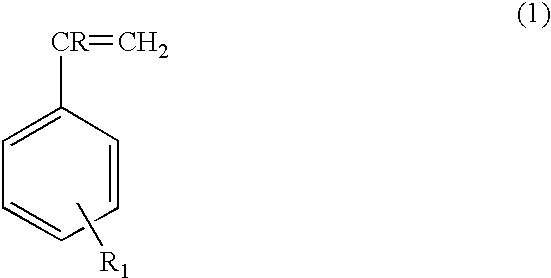Nonformaldehyde, nonfuming resorcinolic resins and methods of making and using the same
a non-fuming, non-formaldehyde technology, applied in the field of resorcinol and resorcinolformaldehyde resins, can solve the problems of difficult to develop an rf type resin containing less than 1.0 wt, increased softening point of the final material due to an increase in its molecular weight, and fuming problems of these resins
- Summary
- Abstract
- Description
- Claims
- Application Information
AI Technical Summary
Problems solved by technology
Method used
Image
Examples
example no.1
EXAMPLE NO. 1
Into a four-necked flask equipped with a mechanical stirrer, thermometer, reflux condenser and an addition funnel, 1.0 mole (110.1 grams) of resorcinol was charged and heated to 125-135.degree. C. When the resorcinol was completely melted, 1.0 gram of PTSA catalyst was added and stirred for 5.0 minutes. After this, 0.25 mole (33.1 grams) of dicyclopentadiene was added from the addition funnel over a period of 60 minutes at 135-145.degree. C. The reaction was continued at this temperature for an additional 60-minute period before heating to 155-160.degree. C. To complete the reaction between resorcinol and dicyclopentadiene, the reaction mixture was stirred for 60 minutes more at 155-160.degree. C. Finally, vacuum was applied to remove any unreacted dicyclopentadiene under 28" of Hg and 155-160.degree. C. temperature conditions. Vacuum distillation did not produce any distillable material, indicating the completion of the resorcinol-dicyclopentadiene reaction. The final ...
example no.2
EXAMPLE NO. 2
In the same manner as described in Example No. 1, another resin was made using 1.0 mole (110.1 grams) of resorcinol and 0.5 mole (66.2 grams) of dicyclopentadiene. The final resin material showed a softening point of 105.2.degree. C. and a free resorcinol content of 20.0 wt. % by the LC / GC analysis.
Though the softening point of this resin is acceptable for rubber compounding applications, the free resorcinol content of 20% is well beyond the level that would characterize this resin as nonfuming. From the experimental results of Examples 1 and 2, there was evidence that the use of dicyclopentadiene alone in the resorcinolic resin synthesis appeared to yield high levels of free resorcinol and to increase the softening point of the reaction product. The details are also given in Table 1, below.
example no.3
EXAMPLE NO. 3
In the same manner as described in Example No. 1, a resin was made using 1.0 mole (110.1 grams) of resorcinol and 1.5 moles (156.2 grams) of styrene instead of dicyclopentadiene. The final resin appeared as a paste with a softening point less than 60.degree. C. and free resorcinol content of 1.4 wt. % (Table 1). Due to the low melting point, handling difficulties would occur both in the commercial production of this material as well as in its use by the tire industry.
PUM
| Property | Measurement | Unit |
|---|---|---|
| temperature | aaaaa | aaaaa |
| softening point | aaaaa | aaaaa |
| temperatures | aaaaa | aaaaa |
Abstract
Description
Claims
Application Information
 Login to View More
Login to View More - R&D
- Intellectual Property
- Life Sciences
- Materials
- Tech Scout
- Unparalleled Data Quality
- Higher Quality Content
- 60% Fewer Hallucinations
Browse by: Latest US Patents, China's latest patents, Technical Efficacy Thesaurus, Application Domain, Technology Topic, Popular Technical Reports.
© 2025 PatSnap. All rights reserved.Legal|Privacy policy|Modern Slavery Act Transparency Statement|Sitemap|About US| Contact US: help@patsnap.com


